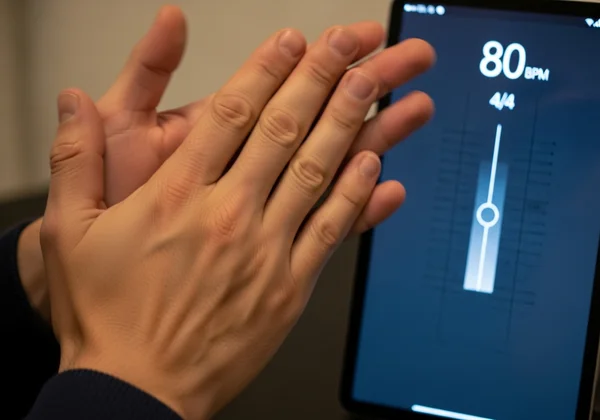Fix Your Timing: Stop Rushing or Dragging with a Metronome
Are you constantly battling the beat? Some days you feel like you’re sprinting ahead of your bandmates, and other days you’re struggling to keep up. That frustrating inconsistency? It's a common hurdle, but it doesn't have to be yours. This guide is your personal rhythm diagnostic, designed to help you identify and conquer common timing issues like rushing and dragging using the precise power of a metronome online. How can a metronome improve my playing consistency? It provides an unwavering, objective source of time that allows you to rebuild your internal clock, one beat at a time.

Our platform offers a powerful, free metronome tool to help you achieve rhythmic perfection. Let’s dive in and fix your timing for good.
Identify Your Timing Tendencies: Are You a Rusher or a Dragger?
Before you can fix a problem, you have to know exactly what it is. Rushing (playing ahead of the beat) and dragging (playing behind the beat) are two sides of the same coin: an unstable internal rhythm. Let's find out which tendency you lean towards.
The Subtle Signs of Rushing the Beat
Rushing is often fueled by adrenaline, excitement, or anxiety. You might be a rusher if you find that the tempo feels faster at the end of a song than when you started, or if your bandmates often give you the "slow down" look. Rushers tend to anticipate the beat, landing their notes just a fraction of a second too early, which can make music feel frantic and unsettled.
Unmasking the Habit of Dragging Tempo
Dragging, on the other hand, can stem from fatigue, technical difficulty, or a lack of focus. If you feel like you're constantly "chasing" the beat or that the music is pulling away from you, you might be dragging. This can make a performance feel lethargic and lose its energy. It often happens during challenging musical passages where your brain and fingers can't quite keep up with the established tempo.
Simple Diagnostic Exercises Using Our Online Metronome
It's time for an honest self-assessment. This simple exercise will give you a clear answer.
- Access our online metronome in your browser.
- Set the BPM to a comfortable, moderate speed, like 80 BPM.
- Choose a 4/4 time signature and ensure the accent on beat one is on.
- Hit "Start" and simply clap your hands on every beat.
- After about 30 seconds, close your eyes and continue clapping, focusing intensely on locking in with the click.
- For the ultimate test, record yourself doing this exercise.
When you listen back, what do you hear? Are your claps consistently just before the click (rushing), or are they slightly after (dragging)? This simple diagnostic is the first step toward building rock-solid time. Don't be discouraged by what you find; awareness is the key to improvement.

Understanding Timing: Why Musicians Rush or Drag
Understanding the root causes of your timing issues can help you address them more effectively. It’s not just about physical coordination; it’s also deeply connected to your mental and technical state.
Psychological Factors Affecting Your Internal Clock
Our perception of time is surprisingly fluid. Nerves before a performance can release adrenaline, literally making your internal clock tick faster and causing you to rush. Conversely, boredom or mental fatigue during a long practice session can slow your internal perception of time, leading to dragging. A lack of concentration is a major culprit; if your mind wanders, your timing will likely wander with it.
Technical Challenges and Physical Tensions
Sometimes, the problem is purely physical. If you're playing a passage that is at the edge of your technical ability, your hands may not be able to keep up, causing you to drag. Unnecessary physical tension is another enemy of good time. If you’re tensing your shoulders, arms, or hands, it restricts your fluidity and makes it nearly impossible to play with a relaxed, consistent groove. Proper breathing is also crucial; holding your breath creates tension and disrupts your natural rhythm.

Precision Practice: Metronome Techniques to Improve Music Timing
Now that you’ve diagnosed your tendency and understand the potential causes, it’s time to use our online metronome as a precision tool for improvement. These metronome practice techniques will help you build an unshakable sense of time.
Starting Slow and Gradually Increasing Tempo
This is the golden rule of practice for a reason. When you practice slowly, you give your brain time to process every note and your muscles time to learn the movements correctly without tension. Set the BPM counter to a speed where you can play a passage perfectly, even if it feels ridiculously slow. Once you can play it flawlessly multiple times in a row, increase the tempo by 2-4 BPM. Repeat this process until you reach your target tempo. This methodical approach isn't just about accuracy; it builds rock-solid control, note by note.
Subdivisions and Accents for Rhythmic Stability
Feeling the space between the beats is just as important as the beats themselves. If you're struggling to lock in, use the subdivision feature on our free tool. Setting it to play eighth notes (two sounds per beat) or sixteenth notes (four sounds per beat) fills in the rhythmic gaps and provides more reference points, making it easier to stay in the pocket. Using the accent feature on beat one also helps you feel the form of the measure, preventing you from getting lost.
The "Silent Beat" and "Metronome on 2 & 4" Exercises
Ready for a challenge? These advanced timing exercises force you to internalize the beat.
- Silent Beat: Set the metronome to 4/4 time. Play for one measure with the click, and then imagine the click for the next measure. The goal is to land perfectly back in time with the metronome when it returns. This trains your internal clock to keep going without an external guide.
- Metronome on 2 & 4: Common in jazz and funk, this exercise helps develop a strong sense of swing and backbeat. Set your metronome to half the target tempo and think of the click as beats 2 and 4. This forces you to feel beats 1 and 3 on your own, dramatically improving your groove.
Recording Yourself for Objective Feedback
Your ears can lie to you in the moment. Recording your practice sessions provides undeniable, objective feedback. As you listen back, you can clearly hear where you rush or drag. It might be humbling, but it is one of the most powerful tools for growth. Pair your recordings with the techniques above and you'll have a complete system for mastering your rhythm.

Master Your Timing: Your Next Steps to Rhythmic Confidence
Rushing or dragging the beat is not a permanent flaw; it's a habit that can be corrected with mindful practice and the right tools. By diagnosing your tendencies, understanding the root causes, and applying targeted metronome practice, you can transform your timing from a source of frustration into a foundation of confidence.
Your rhythmic journey is a marathon, not a sprint. Be patient with yourself, and embrace the process. The key is consistent, focused work. The powerful and customizable features of our free metronome are here to guide you every step of the way.
Ready to build a rock-solid foundation? Start your first diagnostic exercise with our online metronome and take control of your timing today.
FAQ Section
What is a good tempo for practice to fix rushing or dragging?
A good tempo is one where you can play the music perfectly and without tension. For many, this starts in the 60-80 BPM range. The exact number doesn't matter as much as the principle: find the speed where you have complete control, and build up slowly from there using a reliable rhythm practice tool.
How can a metronome improve my playing consistency?
A metronome provides an objective, unwavering reference for time. By practicing with it regularly, you train your brain and body to feel a steady pulse. This internalizes the beat, so even when the metronome is off, your playing remains consistent, solid, and reliable. It’s like a personal trainer for your internal clock.
How do beginners use a metronome effectively to improve timing?
Beginners should start simple. First, just clap or tap along with the metronome to get used to the click. Then, apply it to one-note exercises or simple scales. The goal is not speed, but accuracy. Using a tool like our free metronome online with clear visual cues and subdivision options can make this process much easier and more engaging.